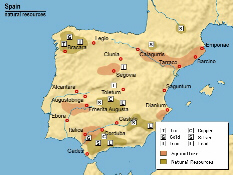
Roman Spain
| Balbvs | Links | History |


Whatever Gades' foundatin date, its possition assured it waelth. As an island state it had some protection from attack, it had a large shelttered bay and was near the mouth of the rivers Gaudalete and Gaudalquivir the best routes for transporting goods.
STRABO A discription of Gades
"here live men who fit out the most and largest merchant-vessals, both for our sea and the outer sea, although, in the first place, it is no large island they live in, and , secondly, they do not occupy much of the continent opposite the island, and, thirdly, they are not well-off in the possession of other islands; indeed, they live mostly on the sea, though a mere few keep at home or else while away their time at Rome. In population, however, Gades does not fall short, it would seem, of any of the cities except Rome; at any rate I have heard that in one of the censuses of our own time (put in date) there were five hundred men assessed as Gaditanian equites - a number not equalled even in the cities of Italy except Patavium. But though the Gaditatians are so numerous, they occupy an island not much larger than a hundred stadia in length, and in places merely a stadium in breath. As for their city, the one they lived in at first was very small indeed, but Balbus of Gades, (the nephew of of ower Balbus) who gained the honour of a triumph, founded another for them, which they call "Nea"; and the city which is composed of the two they call "Didyme" although it is not more than twenty stadia in circuit, and even at that not crowded. For only a few stay at home in the city, because in general they are all at sea, though some live on the continent opposite the island, and also, in particular, on acount of its natural advantages, on the islet that lies of Gades; and because they take delight in its geographical position they have made the islet a rival city, as it were to Didyme. Only a few, however, comparatively speaking, live either on the islet, or in the harbour-town which was constructed for them by Balbus on the opposite coast of the mainland. The city of Gades is situated on the westerly parts of the island; and next to it, at the extremity of the island and near the islet, is the temple of Cronus; but the temple of Heracles is situated on the other side, facing towards the east, just where the island runs, it so happens, most closely to the mainland, thus leaving a strait of only about a stadium in width. And they say that the temple is twelve miles distant from the city, thus making the miles equal to that of the labours; yet the distance is greater than that and amounts to almost as much as the length of the island is that from the west to the east. (Strabo, Geography, 3.5.2-3, Loeb, H.L.Jones)
The island state had had a long association with Rome and Romans. During the second Punic wars it had come over to the romans throwing out the Carthaginian genral Mago that was in 206.PUT IN TABLE OF STATUS AND YEAR. By the time of Balbus' birth the city was probably well on its way to romanization.
For more on Roman Spainclick here
| Balbvs | Links | History |
 And get your own Free Home Page
And get your own Free Home Page